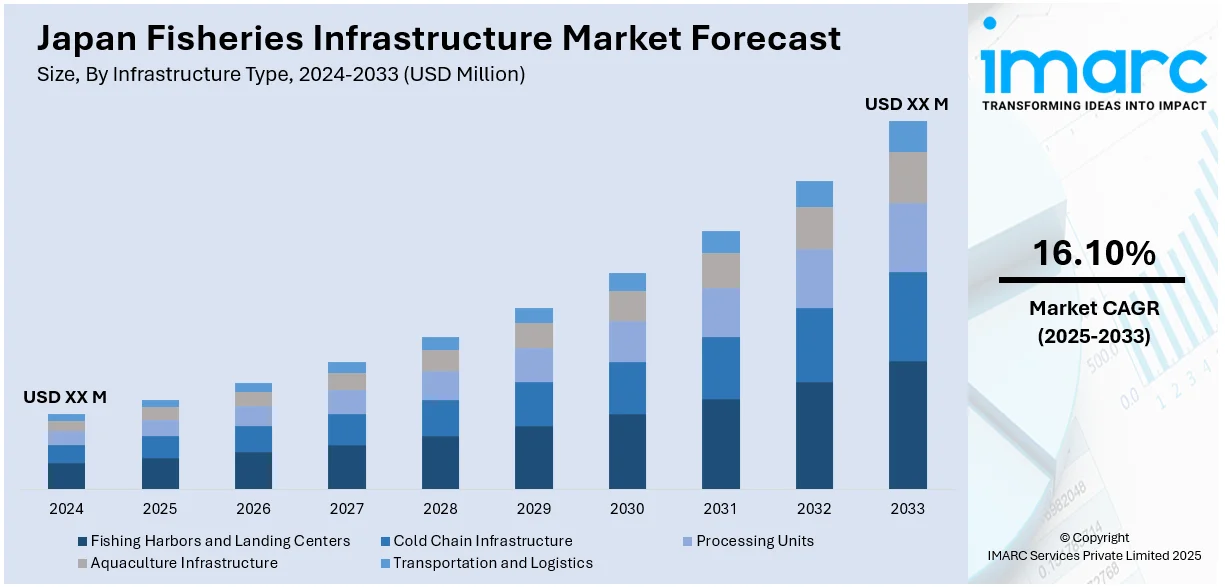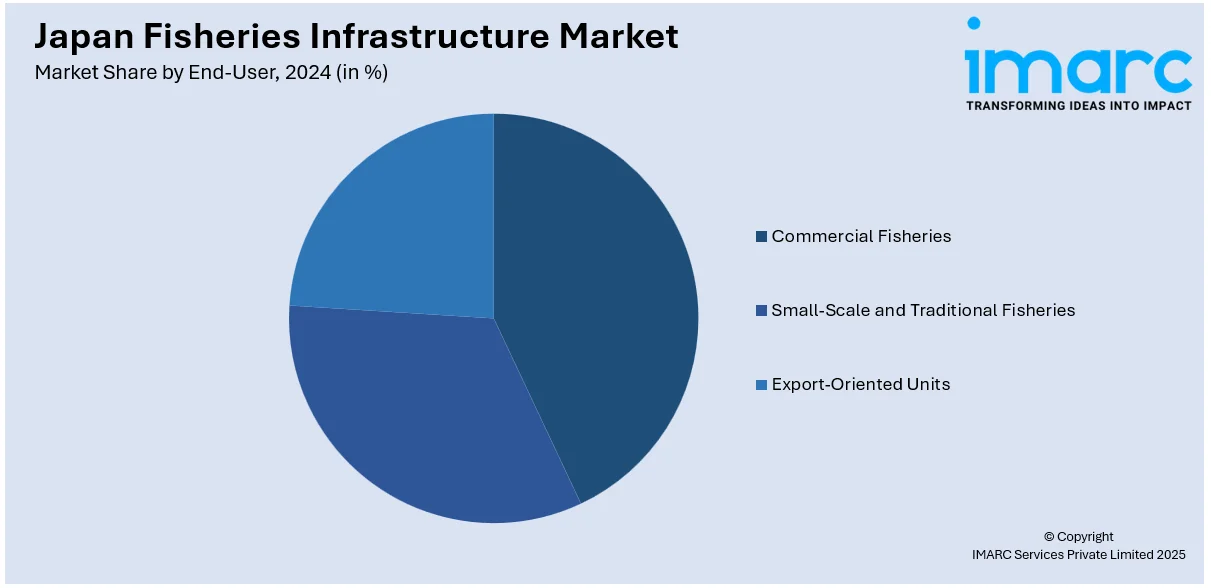
Japan Fisheries Infrastructure Market Size, Share, Trends and Forecast by Infrastructure Type, Sector, End-User, and Region, 2025-2033
Japan Fisheries Infrastructure Market Overview:
The Japan fisheries infrastructure market size is anticipated to exhibit a growth rate (CAGR) of 16.10% during 2025-2033. Key factors driving the market include government reforms, smart aquaculture adoption, investments in artificial reefs, and expansion into seaweed and shellfish farming. These initiatives aim to boost sustainability, productivity, and rural revitalization. Such strategic developments are positively influencing the Japan fisheries infrastructure market share.
|
Report Attribute
|
Key Statistics
|
|---|---|
|
Base Year
|
2024 |
|
Forecast Years
|
2025-2033
|
|
Historical Years
|
2019-2024
|
| Market Growth Rate 2025-2033 | 16.10% |
Japan Fisheries Infrastructure Market Trends:
Smart Aquaculture Integration
Japan's fisheries infrastructure market is experiencing a significant transformation with the integration of smart aquaculture technologies. These technologies utilize Information Communication Technology (ICT), Internet of Things (IoT), Artificial Intelligence (AI), and drones to enhance operational efficiency and sustainability in fish farming. For instance, in December 2024, Ace Aquatec, a Scotland-based aquaculture technology company, secured a significant contract with FRD Japan, a steelhead trout producer, to install its A-HSU humane stunning system at FRD's land-based recirculating aquaculture system (RAS) facility in Chiba, Japan. The bespoke system, designed to meet stringent biosecurity protocols, will facilitate the seamless transfer of fish between grow-out and processing facilities. With a capacity of 30 tonnes per hour and water recycling capabilities, the system underscores Ace Aquatec's commitment to innovation and efficiency in the aquaculture sector. This shift towards smart aquaculture is not only addressing food security challenges but also aligning with Japan's goals of increasing seafood self-sufficiency and reducing environmental impact. The adoption of these technologies is expected to drive the Japan fisheries infrastructure market growth, contributing to its modernization and sustainability.

Sustainable Fisheries
A prominent trend in the Japan fisheries infrastructure market is the shift toward sustainability-focused development. The Japanese government and private stakeholders are increasingly investing in infrastructure that promotes responsible marine resource management. For instance, in September 2024, Japan provided a $10.6 million grant to Fiji to enhance sustainable fisheries through its Economic Social Development Programme. The funding includes a 16-meter fishery research vessel with a 500kW engine and 3-tonne storage, three ice-making machines in Labasa producing nine tonnes daily, and 43 fiberglass boats with 75hp engines for 52 villages. These assets will support fish stock monitoring, combat illegal fishing, and boost coastal fisheries management, aligning with Fiji’s development goals and Japan’s Indo-Pacific cooperation strategy. Moreover, public policies are encouraging collaboration between fisheries cooperatives, research institutions, and technology providers to implement sustainable practices across coastal and offshore fisheries. This growing emphasis on eco-conscious infrastructure reflects Japan’s strategy to ensure long-term viability in its fisheries sector.
Japan Fisheries Infrastructure Market Segmentation:
IMARC Group provides an analysis of the key trends in each segment of the market, along with forecasts at the country/regional levels for 2025-2033. Our report has categorized the market based on infrastructure type, sector, and end-user.
Infrastructure Type Insights:
- Fishing Harbors and Landing Centers
- Cold Chain Infrastructure
- Cold Storage
- Ice Plants
- Processing Units
- Fish Processing Plants
- Packaging Units
- Aquaculture Infrastructure
- Hatcheries
- Feed Plants
- Transportation and Logistics
- Refrigerated Vehicles
- Supply Chain
The report has provided a detailed breakup and analysis of the market based on the infrastructure type. This includes fishing harbors and landing centers, cold chain infrastructure (cold storage and ice plants), processing units (fish processing plants and packaging units), aquaculture infrastructure (hatcheries and feed plants), and transportation and logistics (refrigerated vehicles and supply chain).
Sector Insights:
- Marine Fisheries
- Inland Fisheries
- Aquaculture
A detailed breakup and analysis of the market based on the sector have also been provided in the report. This includes marine fisheries, inland fisheries, and aquaculture.
End-User Insights:

- Commercial Fisheries
- Small-Scale and Traditional Fisheries
- Export-Oriented Units
A detailed breakup and analysis of the market based on the end-user have also been provided in the report. This includes commercial fisheries, small-scale and traditional fisheries, and export-oriented units.
Regional Insights:
- Kanto Region
- Kansai/Kinki Region
- Central/ Chubu Region
- Kyushu-Okinawa Region
- Tohoku Region
- Chugoku Region
- Hokkaido Region
- Shikoku Region
The report has also provided a comprehensive analysis of all the major regional markets, which include Kanto Region, Kansai/Kinki Region, Central/ Chubu Region, Kyushu-Okinawa Region, Tohoku Region, Chugoku Region, Hokkaido Region, and Shikoku Region.
Competitive Landscape:
The market research report has also provided a comprehensive analysis of the competitive landscape. Competitive analysis such as market structure, key player positioning, top winning strategies, competitive dashboard, and company evaluation quadrant has been covered in the report. Also, detailed profiles of all major companies have been provided.
Japan Fisheries Infrastructure Market News:
- In April 2025, Regional Fish Institute, Ltd., a Japanese aquaculture firm, explored collaboration with Cambodian institutions to enhance the country's aquaculture sector. This initiative reflects Japan's growing investment in Cambodia, with 88 Japanese companies registering businesses in the country in 2024, a 20.55% increase from the previous year. Total trade between Cambodia and Japan reached $2.16 billion in 2024, marking a 20.1% rise over 2023.
- In April 2025, Fujitsu, Sonofai Inc., Ishida Tec, and Tokai University launched the SONOFAI T-01, an AI-powered ultrasound device that non-destructively measures the fat content of frozen albacore tuna. This innovation automates quality inspection, reducing labor by up to 80% and increasing accuracy versus traditional visual checks.
Japan Fisheries Infrastructure Market Report Coverage:
| Report Features | Details |
|---|---|
| Base Year of the Analysis | 2024 |
| Historical Period | 2019-2024 |
| Forecast Period | 2025-2033 |
| Units | Million USD |
| Scope of the Report |
Exploration of Historical Trends and Market Outlook, Industry Catalysts and Challenges, Segment-Wise Historical and Future Market Assessment:
|
| Infrastructure Types Covered |
|
| Sectors Covered | Marine Fisheries, Inland Fisheries, Aquaculture |
| End-Users Covered | Commercial Fisheries, Small-Scale and Traditional Fisheries, Export-Oriented Units |
| Regions Covered | Kanto Region, Kansai/Kinki Region, Central/Chubu Region, Kyushu-Okinawa Region, Tohoku Region, Chugoku Region, Hokkaido Region, Shikoku Region |
| Customization Scope | 10% Free Customization |
| Post-Sale Analyst Support | 10-12 Weeks |
| Delivery Format | PDF and Excel through Email (We can also provide the editable version of the report in PPT/Word format on special request) |
Key Questions Answered in This Report:
- How has the Japan fisheries infrastructure market performed so far and how will it perform in the coming years?
- What is the breakup of the Japan fisheries infrastructure market on the basis of infrastructure type?
- What is the breakup of the Japan fisheries infrastructure market on the basis of sector?
- What is the breakup of the Japan fisheries infrastructure market on the basis of end-user?
- What is the breakup of the Japan fisheries infrastructure market on the basis of region?
- What are the various stages in the value chain of the Japan fisheries infrastructure market?
- What are the key driving factors and challenges in the Japan fisheries infrastructure market?
- What is the structure of the Japan fisheries infrastructure market and who are the key players?
- What is the degree of competition in the Japan fisheries infrastructure market?
Key Benefits for Stakeholders:
- IMARC’s industry report offers a comprehensive quantitative analysis of various market segments, historical and current market trends, market forecasts, and dynamics of the Japan fisheries infrastructure market from 2019-2033.
- The research report provides the latest information on the market drivers, challenges, and opportunities in the Japan fisheries infrastructure market.
- Porter's five forces analysis assist stakeholders in assessing the impact of new entrants, competitive rivalry, supplier power, buyer power, and the threat of substitution. It helps stakeholders to analyze the level of competition within the Japan fisheries infrastructure industry and its attractiveness.
- Competitive landscape allows stakeholders to understand their competitive environment and provides an insight into the current positions of key players in the market.
Need more help?
- Speak to our experienced analysts for insights on the current market scenarios.
- Include additional segments and countries to customize the report as per your requirement.
- Gain an unparalleled competitive advantage in your domain by understanding how to utilize the report and positively impacting your operations and revenue.
- For further assistance, please connect with our analysts.
 Request Customization
Request Customization
 Speak to an Analyst
Speak to an Analyst
 Request Brochure
Request Brochure
 Inquire Before Buying
Inquire Before Buying




.webp)




.webp)












